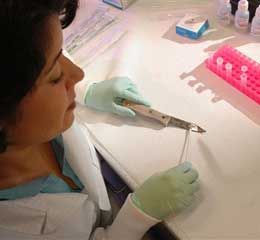Related article:
Forensics ties suspects to unsolved crimes
 A DNA analyst processes evidence in Huntington, W.Va. The university’s Forensic Science Center is providing free DNA testing services to help police solve property crimes. So far, it has provided DNA analysis on more than 950 property crimes cases. (AP Photo) |
By PJ Dickerscheid
The Associated Press
CHARLESTON, W.Va. — Hair, blood, cigarette butts and other items burglars leave behind in capers they think they’ve gotten away with are being analyzed by Marshall University’s crime lab to help lock up crooks in three southern states.
Using annual funding of about $3 million from the National Institute of Justice, the Forensic Science Center is providing free DNA testing to help police solve property crimes in Charleston, S.C.; Miami, Fla.; and now Huntington, W.Va., where Marshall is located.
Most state crime labs don’t have the time and resources to analyze DNA left at burglaries, car break-ins and other property crimes because their priority is on solving homicides, rapes and other violent crimes. That’s where the accredited science lab at Marshall comes in.
In the past two years, the lab has analyzed DNA from more than 950 property crimes in Miami-Dade County and Charleston, said center director Terry Fenger. Huntington joined the pilot program this month.
The Forensic Science Center gives test results to the appropriate state agency with access to CODIS, a national database of DNA profiles of convicted offenders and missing persons. Matches are forwarded to investigators.
The results have “exceeded our wildest expectations,” said Judy Gordon, director of the Charleston Police Department’s Forensic Services Division.
Since four police agencies in the Charleston area joined the program last fall, 27 of 55 DNA samples were matched to known criminals, she said. One suspect was tied to 10 crimes.
DNA from blood a burglar left at a North Charleston home helped police identify a suspect in a crime that netted $1,800 worth of valuables. Tests also led Charleston police to a suspect who broke into the Carolina Polo and Carriage Co. and stole cash and tools.
The program has produced outstanding results for the Miami-Dade County Police Department, which has gotten 255 hits from the hundreds of samples funneled through Marshall’s lab, spokeswoman Nelda Fonticiella said Tuesday.
The three cities were chosen because they represent large, medium and small communities: Miami-Dade County with about 2.4 million people, Charleston County with about 332,000 and Huntington with 38,000.
Analysts were having more success creating DNA profiles from blood, saliva and other biological samples than from “touch” evidence, such as skin cells, oils and sweat, Fenger said.
The turnaround time also is fairly quick, he said. Evidence that might sit for six months or longer waiting to be processed at state crime labs is completed in about 30 days in Miami and 60 days in Charleston.
Charleston hopes to use its experience to help local leaders decide whether to build a regional crime lab capable of handling evidence from both property and more serious crimes, said Bill Deck, project manager at the National Law Enforcement and Corrections Technology Center-Southeast in North Charleston.
The pilot program comes on the heels of a field experiment involving 1,841 cases high-volume crimes in several western U.S. cities, between 2005 and 2007.
Researchers from the Urban Institute’s Justice Policy Center in an April report said DNA analysis led to twice as many suspect identifications, arrests and prosecutions than traditional investigations. Those arrests also involved more dangerous suspects, people with twice as many previous arrests and convictions than those arrested through traditional investigations.
It also determined it costs about $1,400 to process each DNA sample.
While it’s clear DNA can help solve a multitude of crimes, Deck said the real question is whether governments can and want to commit more resources toward it.
“What we need to decide is, can we afford to do this?” he said.

